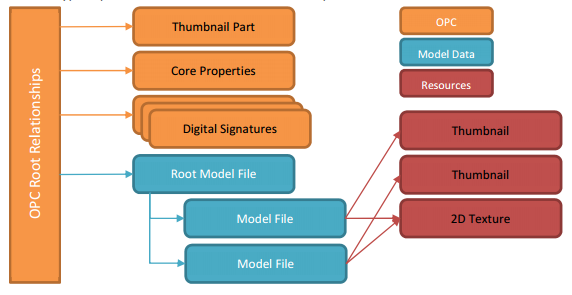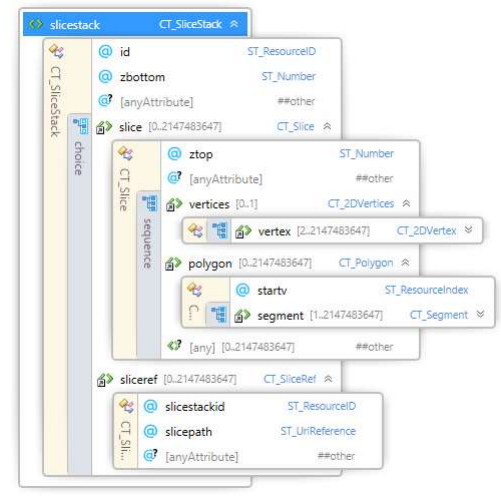 The 3D printing industry is getting ever closer to the adoption of a standardized 3D printing file format. When Microsoft introduced the 3MF file format last year, it was huge news – an updated, 3D printing-specific format promised to eliminate many of the issues that still plague STL and other common formats commonly used for 3D design and printing. Since the announcement of 3MF, its progress has moved rapidly thanks to the numerous companies that make up the 3MF Consortium, which was formed for the collaborative development of the file format.
The 3D printing industry is getting ever closer to the adoption of a standardized 3D printing file format. When Microsoft introduced the 3MF file format last year, it was huge news – an updated, 3D printing-specific format promised to eliminate many of the issues that still plague STL and other common formats commonly used for 3D design and printing. Since the announcement of 3MF, its progress has moved rapidly thanks to the numerous companies that make up the 3MF Consortium, which was formed for the collaborative development of the file format.
Recently, the Consortium brought ASTM International on board to help implement standards for 3MF and get it set for widespread use. At that time, the Consortium stated that the core specifications of the format are ready for adoption, and that they had also developed some extensions to further improve 3MF’s performance. Today, the Consortium released details on two extensions that have been added to the 3MF Core Specification 1.1.
The 3MF Production Extension was designed specifically for users who print at high volume, such as service bureaus. Its purpose is organization, mostly – it allows users to better manage print jobs with multiple parts by keeping them in separate XML files within the 3MF package. The Production Extension makes large print jobs more efficient by dividing the parsing load, and also helps to keep them organized by managing the file hierarchy and relationships among the files while keeping unique identifiers for each part instance.
“High-volume additive manufacturing requires practical software that simplifies the 3D design and manufacturing process while fully describing a model, retaining internal information, color, and other characteristics,” said Alexander Oster, chairman of the 3MF Technical Working Group and Director of Additive Manufacturing at Autodesk. “These extensions were developed to solve in a clear, straightforward manner two critical interoperability issues impacting efficiency and manageability in today’s additive manufacturing facilities.”
The second interoperability issue involves everyone’s favorite part of the 3D printing process: slicing. The lack of standardization for slicing has resulted in a mess of proprietary slicing programs that each define slices differently, leading to print problems, workflow snags, and a lot of frustration and wasted time. The 3MF Slice Extension provides a standardized format for defining slices, keeping data consistent and further simplifying the print process.
“The 3MF Production and 3MF Slice Extensions to our core specification are significant enhancements that move the industry closer to a fully integrated, high-volume additive manufacturing end-to-end 3D printing solution,” said Adrian Lannin, executive director of the 3MF Consortium. “Release of specifications like these aligns with the 3MF Consortium’s mission to help improve the efficiency and productivity of additive manufacturing solutions with standardized software.”
Both the 3MF Production and Slice Extensions are free for download along with the Core Specification. The founding members of the 3MF Consortium currently number at 13, several of whom have already begun using 3MF and its newly released extensions. They haven’t been disappointed.
“HP needs both the Slice and Production extensions to 3MF to take full advantage of the upcoming Jet Fusion printers’ capabilities, to ensure that 3MF content can scale up for industrial-class machines, and to guarantee traceability of jobs, parts, and assemblies through the fabrication process,” said Russell Castronovo, Head of Product Communications for Consortium member HP Inc. “Further, we believe there will be slice-based operations that can take advantage of the Slice Extension to help drive consistency and interoperability between applications and machines going forward. HP has fully implemented both extensions in our first products and we are working with industry partners to ensure adoption of the extensions in their products as well.”
Discuss further over in the 3MF 3D Printing File Format forum at 3DPB.com.
Subscribe to Our Email Newsletter
Stay up-to-date on all the latest news from the 3D printing industry and receive information and offers from third party vendors.
You May Also Like
3D Printing Financials: Fathom Struggles in Financial Quicksand During Critical Transition
Facing a year of key transitions and financial pressures, Fathom (Nasdaq: FTHM) has filed its annual report for 2023 with the U.S. Securities and Exchange Commission (SEC). The document outlines...
Latest Earnings Overview for Australian 3D Printing Firms Titomic and AML3D
Australian 3D printing manufacturing firms Titomic (ASX: TTT) and AML3D (ASX: AL3) reported their financial results for the period from July to December 2023, marking the first half of their...
3D Printing Webinar and Event Roundup: April 7, 2024
Webinars and events in the 3D printing industry are picking back up this week! Sea-Air-Space is coming to Maryland, and SAE International is sponsoring a 3D Systems webinar about 3D...
3D Printing Financials: Unpacking Farsoon and BLT’s 2023 Performance
In the Chinese 3D printing industry, two companies, Farsoon (SHA: 688433) and Bright Laser Technologies, or BLT (SHA: 688333), have recently unveiled their full-year earnings for 2023. Farsoon reported increases...

































